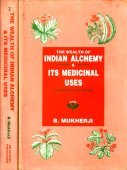Jalanidhi, Jala-nidhi: 14 definitions
Introduction:
Jalanidhi means something in Hinduism, Sanskrit, Buddhism, Pali, the history of ancient India, Marathi. If you want to know the exact meaning, history, etymology or English translation of this term then check out the descriptions on this page. Add your comment or reference to a book if you want to contribute to this summary article.
In Hinduism
Ganitashastra (Mathematics and Algebra)
Source: archive.org: Hindu MathematicsJalanidhi (जलनिधि) represents the number 4 (four) in the “word-numeral system” (bhūtasaṃkhyā), which was used in Sanskrit texts dealing with astronomy, mathematics, metrics, as well as in the dates of inscriptions and manuscripts in ancient Indian literature.—A system of expressing numbers by means of words arranged as in the place-value notation was developed and perfected in India in the early centuries of the Christian era. In this system the numerals [e.g., 4—jalanidhi] are expressed by names of things, beings or concepts, which, naturally or in accordance with the teaching of the Śāstras, connote numbers.

Ganitashastra (शिल्पशास्त्र, gaṇitaśāstra) refers to the ancient Indian science of mathematics, algebra, number theory, arithmetic, etc. Closely allied with astronomy, both were commonly taught and studied in universities, even since the 1st millennium BCE. Ganita-shastra also includes ritualistic math-books such as the Shulba-sutras.
India history and geography
Source: Cologne Digital Sanskrit Dictionaries: Indian Epigraphical GlossaryJalanidhi.—(IE 7-1-2), ‘four’; see sāgara. Note: jalanidhi is defined in the “Indian epigraphical glossary” as it can be found on ancient inscriptions commonly written in Sanskrit, Prakrit or Dravidian languages.

The history of India traces the identification of countries, villages, towns and other regions of India, as well as mythology, zoology, royal dynasties, rulers, tribes, local festivities and traditions and regional languages. Ancient India enjoyed religious freedom and encourages the path of Dharma, a concept common to Buddhism, Hinduism, and Jainism.
Languages of India and abroad
Pali-English dictionary
Source: BuddhaSasana: Concise Pali-English Dictionaryjalanidhi : (m.) the ocean.

Pali is the language of the Tipiṭaka, which is the sacred canon of Theravāda Buddhism and contains much of the Buddha’s speech. Closeley related to Sanskrit, both languages are used interchangeably between religions.
Marathi-English dictionary
Source: DDSA: The Molesworth Marathi and English Dictionaryjalanidhi (जलनिधि).—m S The reservoir of water; " the fountains of the great deep." Ex. jēṇēṃ ja0 āṭalā ācamaniṃ ||.
Source: DDSA: The Aryabhusan school dictionary, Marathi-Englishjalanidhi (जलनिधि).—m The reservoir of water, a sea.
Marathi is an Indo-European language having over 70 million native speakers people in (predominantly) Maharashtra India. Marathi, like many other Indo-Aryan languages, evolved from early forms of Prakrit, which itself is a subset of Sanskrit, one of the most ancient languages of the world.
Sanskrit dictionary
Source: DDSA: The practical Sanskrit-English dictionaryJalanidhi (जलनिधि).—
1) the ocean.
2) the number 'four'.
Derivable forms: jalanidhiḥ (जलनिधिः).
Jalanidhi is a Sanskrit compound consisting of the terms jala and nidhi (निधि).
Source: Cologne Digital Sanskrit Dictionaries: Shabda-Sagara Sanskrit-English DictionaryJalanidhi (जलनिधि).—m.
(-dhiḥ) The ocean. E. jala water and nidhi a nest. nidhīyate asmin ni-dhā-ādhāre ki upa sa0 .
Source: Cologne Digital Sanskrit Dictionaries: Benfey Sanskrit-English DictionaryJalanidhi (जलनिधि).—m. the ocean, [Bhartṛhari, (ed. Bohlen.)] 2, 78.
Jalanidhi is a Sanskrit compound consisting of the terms jala and nidhi (निधि).
Source: Cologne Digital Sanskrit Dictionaries: Cappeller Sanskrit-English DictionaryJalanidhi (जलनिधि).—[masculine] the same.
Source: Cologne Digital Sanskrit Dictionaries: Monier-Williams Sanskrit-English Dictionary1) Jalanidhi (जलनिधि):—[=jala-nidhi] [from jala] m. ‘water-treasure’, the ocean, [Mahābhārata iii, 15817; Pañcatantra; Varāha-mihira’s Bṛhat-saṃhitā; Bhartṛhari; Prabodha-candrodaya]
2) [v.s. ...] Name of a man, [Saṃskārakaustubha]
Source: Cologne Digital Sanskrit Dictionaries: Yates Sanskrit-English DictionaryJalanidhi (जलनिधि):—[jala-nidhi] (dhiḥ) 2. m. The ocean.
[Sanskrit to German]
Sanskrit, also spelled संस्कृतम् (saṃskṛtam), is an ancient language of India commonly seen as the grandmother of the Indo-European language family (even English!). Closely allied with Prakrit and Pali, Sanskrit is more exhaustive in both grammar and terms and has the most extensive collection of literature in the world, greatly surpassing its sister-languages Greek and Latin.
Kannada-English dictionary
Source: Alar: Kannada-English corpusJalanidhi (ಜಲನಿಧಿ):—[noun] = ಜಲಧಿ [jaladhi].
--- OR ---
Jaḷanidhi (ಜಳನಿಧಿ):—[noun] = ಜಳಧಿ [jaladhi].
Kannada is a Dravidian language (as opposed to the Indo-European language family) mainly spoken in the southwestern region of India.
See also (Relevant definitions)
Partial matches: Jala, Nidhi, Niti.
Starts with: Jalanidhinatha, Jalanidhivacas.
Ends with: Aparajalanidhi, Lavanajalanidhi, Rasajalanidhi.
Full-text: Jalanidhivacas, Lavanajalanidhi, Calaniti, Lavanajaladhi, Samarabh, Lanka.
Relevant text
Search found 10 books and stories containing Jalanidhi, Jala-nidhi, Jaḷanidhi, Jaḷa-nidhi; (plurals include: Jalanidhis, nidhis, Jaḷanidhis). You can also click to the full overview containing English textual excerpts. Below are direct links for the most relevant articles:
Chaitanya Bhagavata (by Bhumipati Dāsa)
Verse 2.18.135 < [Chapter 18 - Mahāprabhu’s Dancing as a Gopī]
Rasa Jala Nidhi, vol 5: Treatment of various afflictions (by Bhudeb Mookerjee)
Part 24 - Hindu Chemistry before the advent of the Mahomedans < [A Brief History of Indian Chemistry and Medicine]
Part 1 - Introduction (justifying ancient Indian knowledge of the use of mercury) < [A Brief History of Indian Chemistry and Medicine]
Rasa Jala Nidhi, vol 3: Metals, Gems and other substances (by Bhudeb Mookerjee)
Rasa Jala Nidhi, vol 4: Iatrochemistry (by Bhudeb Mookerjee)
Sahitya-kaumudi by Baladeva Vidyabhushana (by Gaurapada Dāsa)
Text 10.121 < [Chapter 10 - Ornaments of Meaning]
Free India < [October – December, 1997]
Related products
